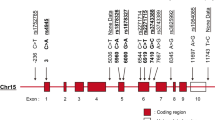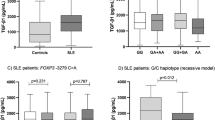Abstract
Osteopontin (OPN) is a multifunctional cytokine involved in long bone remodeling and immune system signaling. Additionally, OPN is critical for interferon-α (IFN-α) production in murine plasmacytoid dendritic cells. We have previously shown that IFN-α is a heritable risk factor for systemic lupus erythematosus (SLE). Genetic variants of OPN have been associated with SLE susceptibility, and one study suggests that this association is particular to men. In this study, the 3′ UTR SLE-risk variant of OPN (rs9138C) was associated with higher serum OPN and IFN-α in men (P=0.0062 and P=0.0087, respectively). In women, the association between rs9138 C and higher serum OPN and IFN-α was restricted to younger subjects, and risk allele carriers showed a strong age-related genetic effect of rs9138 genotype on both serum OPN and IFN-α (P<0.0001). In African-American subjects, the 5′ region single nucleotide polymorphisms, rs11730582 and rs28357094, were associated with anti-RNP antibodies (odds ratio (OR)=2.9, P=0.0038 and OR=3.9, P=0.021, respectively). Thus, we demonstrate two distinct genetic influences of OPN on serum protein traits in SLE patients, which correspond to previously reported SLE-risk variants. This study provides a biologic relevance for OPN variants at the protein level, and suggests an influence of this gene on the IFN-α pathway in SLE.
This is a preview of subscription content, access via your institution
Access options
Subscribe to this journal
Receive 6 digital issues and online access to articles
$119.00 per year
only $19.83 per issue
Buy this article
- Purchase on Springer Link
- Instant access to full article PDF
Prices may be subject to local taxes which are calculated during checkout





Similar content being viewed by others
References
Harley JB, Kelly JA, Kaufman KM . Unraveling the genetics of systemic lupus erythematosus. Springer Semin Immunopathol 2006; 28: 119–130.
Blanco P, Palucka AK, Gill M, Pascual V, Banchereau J . Induction of dendritic cell differentiation by IFN-alpha in systemic lupus erythematosus. Science 2001; 294: 1540–1543.
Hooks JJ, Moutsopoulos HM, Geis SA, Stahl NI, Decker JL, Notkins AL . Immune interferon in the circulation of patients with autoimmune disease. N Engl J Med 1979; 301: 5–8.
Kirou KA, Lee C, George S, Louca K, Peterson MG, Crow MK . Activation of the interferon-alpha pathway identifies a subgroup of systemic lupus erythematosus patients with distinct serologic features and active disease. Arthritis Rheum 2005; 52: 1491–1503.
Ronnblom LE, Alm GV, Oberg KE . Possible induction of systemic lupus erythematosus by interferon-alpha treatment in a patient with a malignant carcinoid tumour. J Intern Med 1990; 227: 207–210.
Niewold TB, Swedler WI . Systemic lupus erythematosus arising during interferon-alpha therapy for cryoglobulinemic vasculitis associated with hepatitis C. Clin Rheumatol 2005; 24: 178–181.
Niewold TB, Hua J, Lehman TJ, Harley JB, Crow MK . High serum IFN-alpha activity is a heritable risk factor for systemic lupus erythematosus. Genes Immun 2007; 8: 492–502.
Niewold TB, Kelly JA, Flesch MH, Espinoza LR, Harley JB, Crow MK . Association of the IRF5 risk haplotype with high serum interferon-alpha activity in systemic lupus erythematosus patients. Arthritis Rheum 2008; 58: 2481–2487.
Kariuki SN, Crow MK, Niewold TB . The PTPN22 C1858T polymorphism is associated with skewing of cytokine profiles toward high interferon-alpha activity and low tumor necrosis factor alpha levels in patients with lupus. Arthritis Rheum 2008; 58: 2818–2823.
Denhardt DT, Noda M . Osteopontin expression and function: role in bone remodeling. J Cell Biochem Suppl 1998; 30–31: 92–102.
Lampe MA, Patarca R, Iregui MV, Cantor H . Polyclonal B cell activation by the Eta-1 cytokine and the development of systemic autoimmune disease. J Immunol 1991; 147: 2902–2906.
Scatena M, Liaw L, Giachelli CM . Osteopontin: a multifunctional molecule regulating chronic inflammation and vascular disease. Arterioscler Thromb Vasc Biol 2007; 27: 2302–2309.
Masutani K, Akahoshi M, Tsuruya K, Tokumoto M, Ninomiya T, Kohsaka T et al. Predominance of Th1 immune response in diffuse proliferative lupus nephritis. Arthritis Rheum 2001; 44: 2097–2106.
Chabas D, Baranzini SE, Mitchell D, Bernard CC, Rittling SR, Denhardt DT et al. The influence of the proinflammatory cytokine, osteopontin, on autoimmune demyelinating disease. Science 2001; 294: 1731–1735.
Forton AC, Petri MA, Goldman D, Sullivan KE . An osteopontin (SPP1) polymorphism is associated with systemic lupus erythematosus. Hum Mutat 2002; 19: 459.
D'Alfonso S, Barizzone N, Giordano M, Chiocchetti A, Magnani C, Castelli L et al. Two single-nucleotide polymorphisms in the 5′ and 3′ ends of the osteopontin gene contribute to susceptibility to systemic lupus erythematosus. Arthritis Rheum 2005; 52: 539–547.
Han S, Guthridge JM, Harley IT, Sestak AL, Kim-Howard X, Kaufman KM et al. Osteopontin and systemic lupus erythematosus association: a probable gene-gender interaction. PLoS ONE 2008; 3: e0001757.
Shinohara ML, Lu L, Bu J, Werneck MB, Kobayashi KS, Glimcher LH et al. Osteopontin expression is essential for interferon-alpha production by plasmacytoid dendritic cells. Nat Immunol 2006; 7: 498–506.
Niewold TB, Adler JE, Glenn SB, Lehman TJ, Harley JB, Crow MK . Age- and sex-related patterns of serum interferon-alpha activity in lupus families. Arthritis Rheum 2008; 58: 2113–2119.
Breslow NE . Statistics in epidemiology: the case-control study. J Am Stat Assoc 1996; 91: 14–28.
Sigurdsson S, Nordmark G, Garnier S, Grundberg E, Kwan T, Nilsson O et al. A risk haplotype of STAT4 for systemic lupus erythematosus is over-expressed, correlates with anti-dsDNA and shows additive effects with two risk alleles of IRF5. Hum Mol Genet 2008; 17: 2868–2876.
Kariuki SN, Kirou KA, MacDermott EJ, Barillas-Arias L, Crow MK, Niewold TB . Cutting edge: autoimmune disease risk variant of STAT4 confers increased sensitivity to IFN-alpha in lupus patients in vivo. J Immunol 2009; 182: 34–38.
Vanacker JM, Delmarre C, Guo X, Laudet V . Activation of the osteopontin promoter by the orphan nuclear receptor estrogen receptor related alpha. Cell Growth Differ 1998; 9: 1007–1014.
Zirngibl RA, Chan JS, Aubin JE . Estrogen receptor-related receptor alpha (ERRalpha) regulates osteopontin expression through a non-canonical ERRalpha response element in a cell context-dependent manner. J Mol Endocrinol 2008; 40: 61–73.
Lovgren T, Eloranta ML, Bave U, Alm GV, Ronnblom L . Induction of interferon-alpha production in plasmacytoid dendritic cells by immune complexes containing nucleic acid released by necrotic or late apoptotic cells and lupus IgG. Arthritis Rheum 2004; 50: 1861–1872.
Tan EM, Cohen AS, Fries JF, Masi AT, McShane DJ, Rothfield NF et al. The 1982 revised criteria for the classification of systemic lupus erythematosus. Arthritis Rheum 1982; 25: 1271–1277.
Hua J, Kirou K, Lee C, Crow MK . Functional assay of type I interferon in systemic lupus erythematosus plasma and association with anti-RNA binding protein autoantibodies. Arthritis Rheum 2006; 54: 1906–1916.
Plumer A, Duan H, Subramaniam S, Lucas FL, Miesfeldt S, Ng AK et al. Development of fragment-specific osteopontin antibodies and ELISA for quantification in human metastatic breast cancer. BMC Cancer 2008; 8: 38.
Acknowledgements
Grant support and disclosures: SN Kariuki – none; JG Moore – none; KA Kirou – patent pending for interferon assay; MK Crow – NIH AI059893, Alliance for Lupus Research, Mary Kirkland Center for Lupus Research, Lupus Research Institute, and patent pending for interferon assay; TO Utset – Lupus Clinical Trials Consortium, Genentech; TB Niewold – NIH CTSA K12 Scholar Award RR025000-02, NIAID Clinical Research Loan Repayment AI071651, Arthritis Foundation Post-Doctoral Fellowship Award, Arthritis National Research Foundation Scholar Award.
Author information
Authors and Affiliations
Corresponding author
Additional information
Supplementary Information accompanies the paper on Genes and Immunity website (http://www.nature.com/gene)
Supplementary information
Rights and permissions
About this article
Cite this article
Kariuki, S., Moore, J., Kirou, K. et al. Age- and gender-specific modulation of serum osteopontin and interferon-α by osteopontin genotype in systemic lupus erythematosus. Genes Immun 10, 487–494 (2009). https://doi.org/10.1038/gene.2009.15
Received:
Revised:
Accepted:
Published:
Issue Date:
DOI: https://doi.org/10.1038/gene.2009.15



